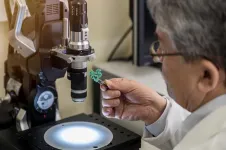(Press-News.org) June 16, 2021, CLEVELAND: New findings from Cleveland Clinic researchers show for the first time that the gut microbiome impacts stroke severity and functional impairment following stroke. The results, published in Cell Host & Microbe, lay the groundwork for potential new interventions to help treat or prevent stroke.
The research was led by Weifei Zhu, Ph.D., and Stanley Hazen, M.D., Ph.D., of Cleveland Clinic's Lerner Research Institute. The study builds on more than a decade of research spearheaded by Dr. Hazen and his team related to the gut microbiome's role in cardiovascular health and disease, including the adverse effects of TMAO (trimethylamine N-oxide) - a byproduct produced when gut bacteria digest certain nutrients abundant in red meat and other animal products.
"In this study we found that dietary choline and TMAO produced greater stroke size and severity, and poorer outcomes in animal models," said Dr. Hazen, chair of the Department of Cardiovascular & Metabolic Sciences and director of Cleveland Clinic's Center for Microbiome & Human Health. "Remarkably, simply transplanting gut microbes capable of making TMAO was enough to cause a profound change in stroke severity."
Previously, Dr. Hazen and his team discovered that elevated TMAO levels can lead to the development of cardiovascular disease. In clinical studies involving thousands of patients, they have shown that blood levels of TMAO predict future risk of heart attack, stroke and death -findings that have been replicated around the world. Earlier studies, also led by Drs. Zhu and Hazen, were the first to show a link between TMAO and enhanced risk for blood clotting.
"This new study expands on these findings, and for the first time provides proof that gut microbes in general - and through TMAO specifically - can directly impact stroke severity or post-stroke functional impairment," said Dr. Hazen.
The researchers compared brain damage in preclinical stroke models between those with elevated or reduced TMAO levels. Over time, those with higher levels of TMAO had more extensive brain damage and a greater degree of motor and cognitive functional deficits following stroke. The researchers also found that dietary changes that alter TMAO levels, such as eating less red meat and eggs, impacted stroke severity.
"Functionality after a stroke - which occurs when blood flow to the brain is blocked - is a major concern for patients," said Dr. Hazen, who is also co-section head of Preventive Cardiology & Cardiac Rehabilitation in Cleveland Clinic's Miller Heart, Vascular & Thoracic Institute. "To understand if choline and TMAO affect post-stroke functionality, in addition to stroke severity, we compared performance on various tasks pre-stroke, and then both in the short- and long-term following stroke."
The team found that a gut microbe enzyme critical to TMAO production called CutC drove heightened stroke severity and worsened outcomes.
According to Dr. Zhu, targeting this gut microbe enzyme may be a promising approach to prevent stroke. "When we genetically silenced the gut microbe gene that encodes CutC, stroke severity significantly diminished," she said. "Ongoing research is exploring this treatment approach, as well as the potential for dietary interventions to help reduce TMAO levels and stroke risk, since both a Western diet and a diet rich in red meat are known to elevate TMAO levels. Switching to plant-based protein sources helps to lower TMAO."
INFORMATION:
Dr. Hazen is an elected member of the National Academy of Medicine and holds the Jan Bleeksma Chair in Vascular Biology and Atherosclerosis, and the Leonard Krieger Chair in Preventive Cardiology at Cleveland Clinic. His seminal discoveries related to TMAO have been replicated around the world, and TMAO testing has been widely adopted in clinical practice.
The study was supported in part by the National Heart, Lung, and Blood Institute. After the article publishes, it will be available at: https://www.cell.com/cell-host-microbe/fulltext/S1931-3128(21)00230-4
About Cleveland Clinic
Cleveland Clinic - now in its centennial year - is a nonprofit multispecialty academic medical center that integrates clinical and hospital care with research and education. Located in Cleveland, Ohio, it was founded in 1921 by four renowned physicians with a vision of providing outstanding patient care based upon the principles of cooperation, compassion and innovation. Cleveland Clinic has pioneered many medical breakthroughs, including coronary artery bypass surgery and the first face transplant in the United States. U.S. News & World Report consistently names Cleveland Clinic as one of the nation's best hospitals in its annual "America's Best Hospitals" survey. Among Cleveland Clinic's 70,800 employees worldwide are more than 4,660 salaried physicians and researchers, and 18,500 registered nurses and advanced practice providers, representing 140 medical specialties and subspecialties. Cleveland Clinic is a 6,500-bed health system that includes a 173-acre main campus near downtown Cleveland, 19 hospitals, more than 220 outpatient facilities, and locations in southeast Florida; Las Vegas, Nevada; Toronto, Canada; Abu Dhabi, UAE; and London, England. In 2020, there were 8.7 million total outpatient visits, 273,000 hospital admissions and observations, and 217,000 surgical cases throughout Cleveland Clinic's health system. Patients came for treatment from every state and 185 countries. Visit us at clevelandclinic.org. Follow us at twitter.com/ClevelandClinic. News and resources available at newsroom.clevelandclinic.org.
Our eyes move three times per second. Every time we move our eyes, the world in front of us flies across the retina at the back of our eyes, dramatically shifting the image the eyes send to the brain; yet, as far as we can tell, nothing appears to move. A new study provides new insight into this process known as "visual stabilization". The results are published in the Proceedings of the National Academy of Sciences.
"Our results show that a framing strategy is at work behind the scenes all the time, which helps stabilize our visual experience," says senior author Patrick Cavanagh, a research professor in psychological and brain sciences at Dartmouth ...
A joint paper went out in Journal of Petroleum Science and Engineering.
Petroleum, being a liquid compound, has very good migratory properties, and recovery methods take account of that - using various methods, oilers displace petroleum through cavities and vugs and extract it. However, sometimes oil is "locked" in low-permeability reservoirs, and water displacement used in such cases poses a high risk of reservoir flooding and workplace emergencies.
Many teams work on blocking high-permeability areas in order to make extraction a more controlled and safe process. In particular, there have yet been no efficient agents for reservoirs with high temperatures (up to 140 C) and mineralization (up to 250 grams ...
Professor Hermann Ehrlich places a piece of sponge in an alkaline, copper-containing ammonia solution that simulates a copper bath from the manufacture of circuit boards for electronic components. About 12 hours later the sponge has turned blue - when dry it is stronger than before, but still very light. "At a pH value of 9 the fibers of the spongin open and the organic compounds of the protein change," explains Prof. Hermann Ehrlich. The copper contained in the ammonia solution reacts immediately with the organic components of the spongin, especially with the amino acid residues, and forms the mineral atacamite. "Like a string, nanometer-sized crystals grow along with the spongin fiber," explains the scientist. ...
Olives, well-known for their characteristic bitter taste, are in high demand owing to the popularity of the oil that's derived from them. The health benefits of olive oil are well known, ranging from antiviral, anti-cancer, to even anti-hypertensive effects. These benefits are attributed to "oleuropein," the most abundant olive secoiridoid found in olives.
An efficient method to enhance the quality of plant products is by using molecular methods to manipulate their genes and enhancing their yield. With olives, however, this is still a challenge, because of a lack of sufficient genome data.
So far, the genomes of two European olive varieties have been sequenced. But to fully decipher ...
Lack of data on contraception uptake prior to the pandemic means no clear picture of the impact Covid-19 had on contraception use
Study from Warwick Medical School highlights need to maintain access to contraception during disasters
Researchers recommend making more contraception prescription-free and discuss the benefits and pitfalls of telehealth
Limited data on the uptake of contraception prior to and during crises such as the Covid-19 pandemic could mean unforeseen issues for sexual and reproductive health services, research from the University of Warwick concludes.
It identifies additional barriers that women faced in accessing contraception during the Covid-19 lockdown, including disruption to sexual health services and fears about contracting the virus, as ...
New research shows the UK's COVID-19 management decisions were based on an outdated pandemic modelling structure and suggests a more resilient approach would have been more effective.
In the initial months of the pandemic, regular updates using graphs showing how the R number was behaving was the mainstay of the Government's strategy for tackling COVID-19.
This type of infection transmission is usually mathematically-based on dividing the population into 'compartments'. Such an approach has been criticised for its limited scope and inability to capture critical factors, such as the ...
Results show BAT's Modern Oral nicotine pouches have a comparable toxicant profile to NRTs, which are currently considered the least risky of all nicotine products*†
The Modern Oral products have far fewer and significantly lower levels of toxicants‡ than cigarette smoke
Data demonstrates how BAT is building A Better Tomorrow™ by providing evidence to show how we are reducing the health impact of our business and delivering Tobacco Harm Reduction
London, 16 June: New research published today indicates that BAT's modern oral (MO) products in the form of tobacco-free nicotine pouches have a toxicant profile that is comparable to nicotine replacement therapies (NRTs) and much lower than traditional oral ...
CHAPEL HILL, NC - UNC School of Medicine scientists led a collaboration of researchers to demonstrate a potentially powerful new strategy for treating cystic fibrosis (CF) and potentially a wide range of other diseases. It involves small, nucleic acid molecules called oligonucleotides that can correct some of the gene defects that underlie CF but are not addressed by existing modulator therapies. The researchers used a new delivery method that overcomes traditional obstacles of getting oligonucleotides into lung cells.
As the scientists reported in the journal Nucleic Acids Research, they demonstrated the striking effectiveness of their approach in cells derived from a CF patient and in mice.
"With our oligonucleotide delivery platform, we were able to restore the activity of ...
Stuttgart/Boulder - It is not the first time that spiders have served as biological models in the research field of soft robotics. The hydraulic actuation mechanisms they apply to move their limbs when weaving their web or hunting for prey give them powers many roboticists and engineers have drawn inspiration from.
A team of researchers at the Max Planck Institute for Intelligent Systems in Germany and at the University of Boulder in Colorado in the US has now found a new way to exploit the principles of spiders' joints to drive articulated robots without any bulky components and connectors, which weigh down the robot and reduce portability and speed. Their slender and lightweight simple ...
Magnetic-spin interactions that allow spin-manipulation by electrical control allow potential applications in energy-efficient spintronic devices.
An antisymmetric exchange known as Dzyaloshinskii-Moriya interactions (DMI) is vital to form various chiral spin textures, such as skyrmions, and permits their potential application in energy-efficient spintronic devices.
Published this week, a Chinese-Australia collaboration has for the first time illustrated that DMI can be induced in a layered material tantalum-sulfide (TaS2) by intercalating iron atoms, and can further be tuned by gate-induced proton intercalation.
REALIZING AND TUNING DMI IN VAN-DER-WAALS MATERIAL TaS2
Searching ...






